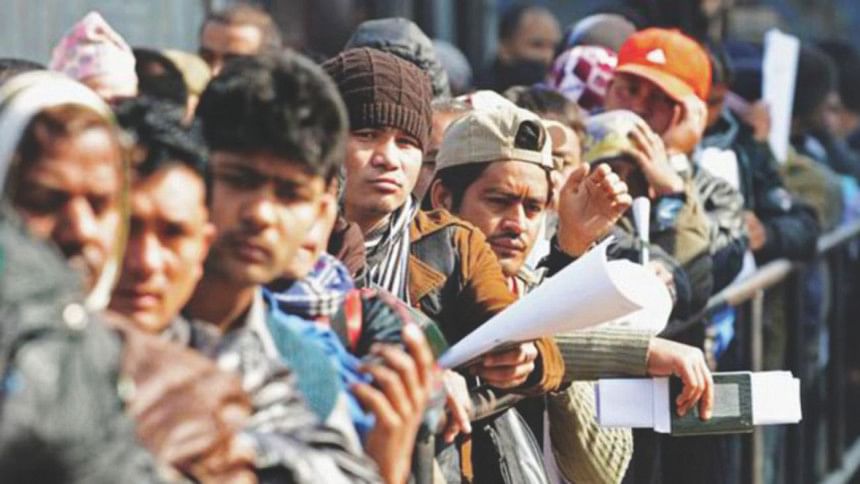Back home, to what?

Migration is a naturally occurring phenomenon in existence since thousands of years ago. The first men migrated out of Africa to different parts of the world – making civilisation as diverse as it is today. Mughals came to this part of the world from central Asia and long before them, the Aryans. But what is common among all these cases of migration from different times with different groups of people? The answer to that is simple: allure of better opportunity. Migration was not only economically viable but there were social elements added in the mix too. People did not move out of sheer boredom; they wanted their footprints in newer lands with the hope of a secure future. Fast forward a few hundred years and we are see the same thing all over again in Europe. With thousands of people running away from their lives in Syria and other conflict-ridden areas in the Middle East, many are never making it to the new promised lands.
The people of Bangladesh are no stranger to migration. An estimated five million Bangladeshis are currently working overseas, contributing greatly to their families, communities and the country's economy through remittances. Remittances sent by migrants through official channels reached a record high level of USD 15 billion in 2015, making it the 8th highest remittance-earning country in the world. Naturally, migration is increasingly being recognised as a viable livelihood option and one of the major sectors the government is looking to strengthen.
Record-breaking as it is, the growth in migration from Bangladesh, increasing levels of remittances and its consequential benefits to the country are not without its challenges. Irregular migration, informal channels of remittance and human trafficking continue to result in serious violations of human rights. Other contributing factors include irregular recruitment practices and abuses, rising migration costs, a lack of information and data, and follow-up with returning migrants who have greater vulnerability in terms of infectious diseases, psychological well-being and lack of access to appropriate health services.
Migration can lead to so many discussions pertinent to human rights, economic empowerment and social development that it is too easy to lose focus trying to do everything together. One salient feature of any migration process that remains under the cover is the fate of people who come back to their countries.
We always talk about the perils of overseas migration. Almost all organisations who are working with migrants in Bangladesh focus on them during the pre-departure stage, which is definitely useful – but is just one chapter of the story. Migrants need support from the government of destination countries and Bangladesh embassies to exercise their rights and a strong reintegration mechanism when they return to Bangladesh. The returning migrants can be a source of inspiration or subject of nightmares for their communities, depending on their experiences overseas.
With the support of UN Women in Bangladesh, BRAC took on a project focusing on the returning migrants to see exactly that -- what happened to them when they came back and what kind of support can be provided to them?
Reintegration of returning migrant workers is a new concept in the context of Bangladesh. Last year, in October 2014, to promote work through migration policy and application in Bangladesh, an eleven-month long project was launched in collaboration with the Government of Bangladesh, ILO and Swiss Development Corporation. A Standard Operating Procedure (SOP) was developed as a guide for the referral and reintegration services. These services were provided through support and resource centres established in Dhaka, Manikganj and Faridpur, covering eight sub-districts and reaching more than 25,000 people who are actively involved with migration.
More than 500 returning migrants have received referral services, economic grants, medical support and psychosocial counselling through support centres so far. Working relationships established with service providers under this project need to continue with consistent support and long-term intervention is required in this regard. The government, being the chief stakeholder, needs to endorse the SOP and gender responsive services that will have positive and significant impact on the lives of returning migrant workers, especially women.
Since September 2010, the United Nations has been working on the next set of development goals, following the MDGs - a set of eight global goals set in 2000 - which saw the largest anti-poverty movement in the history of mankind. Unfortunately the MDGs did not include safe migration or migrant workers' rights as one of the goals, despite there being direct links with some of the major goals. Last month the next set of global goals, the Sustainable Development Goals (SDG), were declared in the UN General Summit, amidst the presence of the world leaders from 193 UN member states. In the SDGs ,migration features prominently under two goals where the rights of migrant workers, especially women migrants, and the facilitation of safe migration process were emphasised. The road to achieve these targets is heavily linked with other goals like ending poverty and creating employment for all. Nonetheless, it is admirable that the international community is taking the issue of migration seriously and the whole world is behind it.
The writers work in BRAC Communications.

 For all latest news, follow The Daily Star's Google News channel.
For all latest news, follow The Daily Star's Google News channel. 



Comments